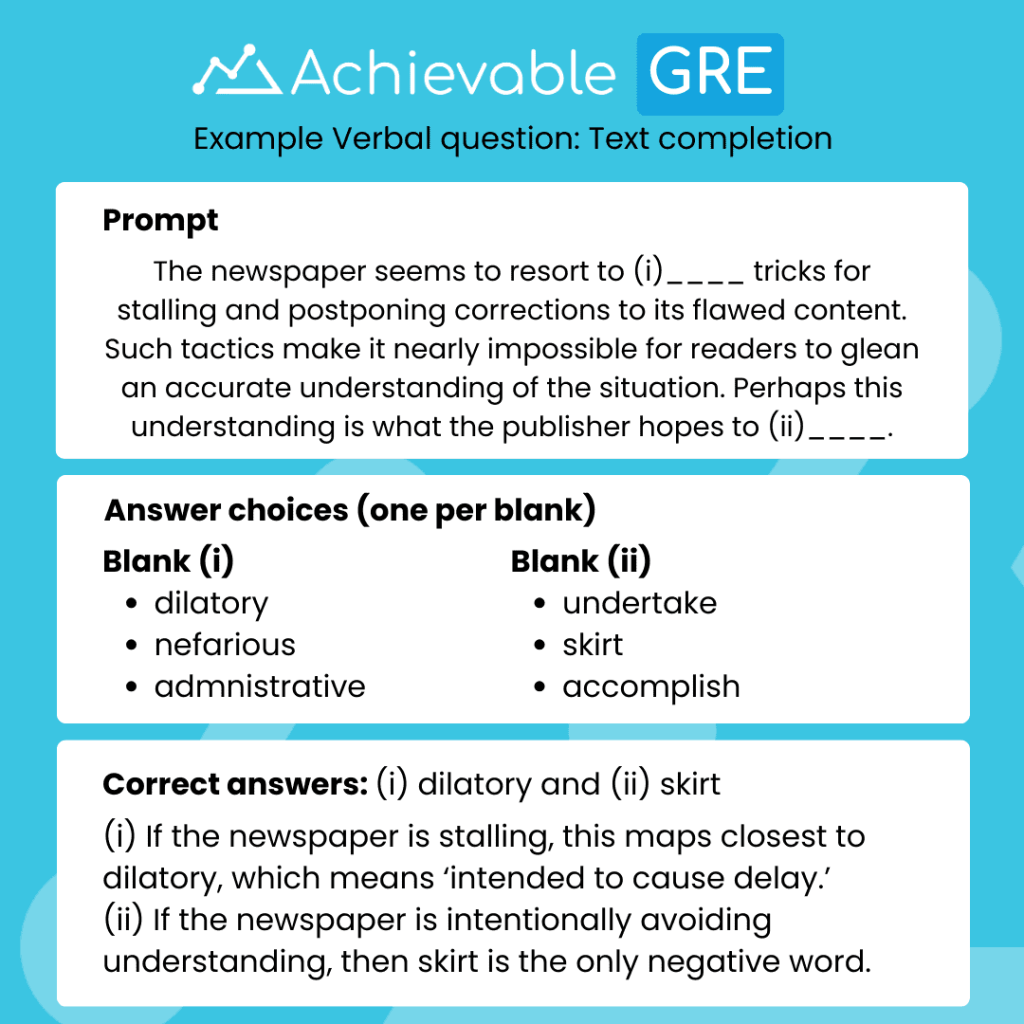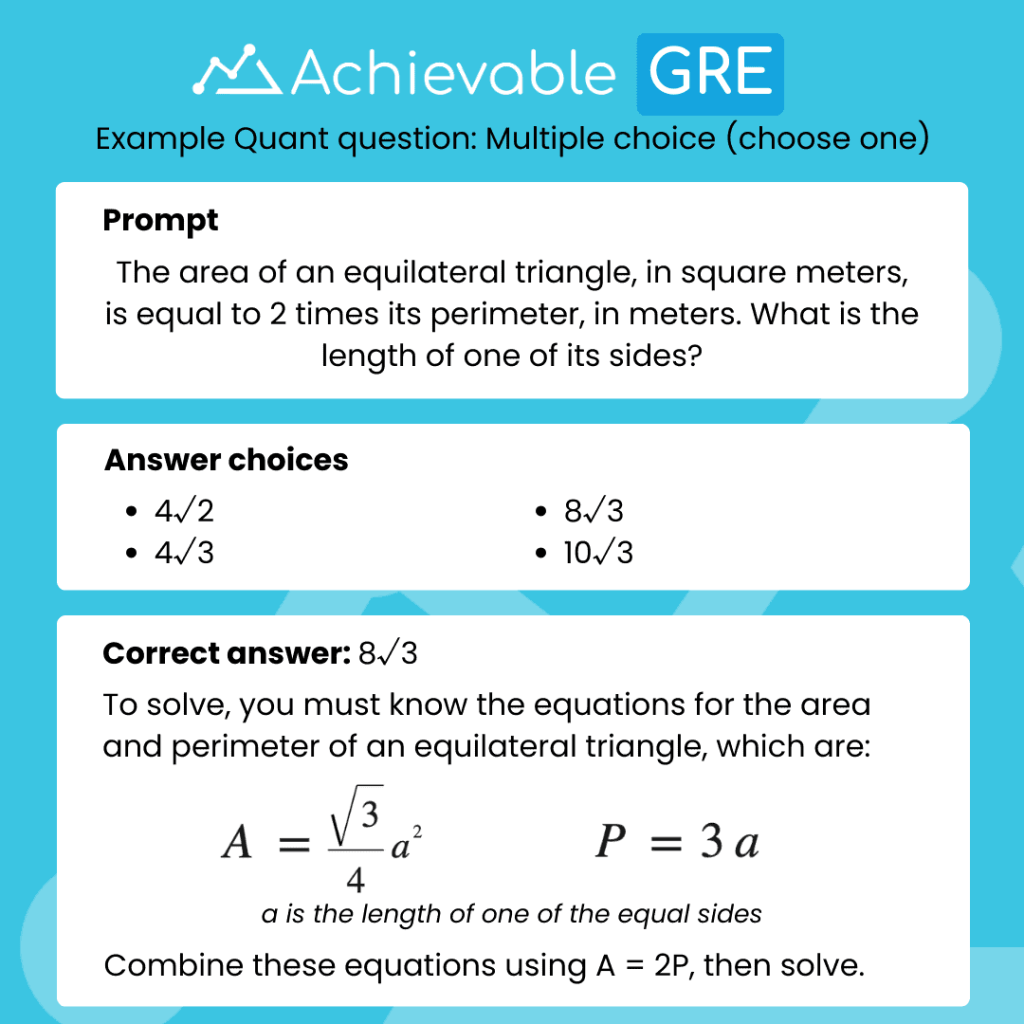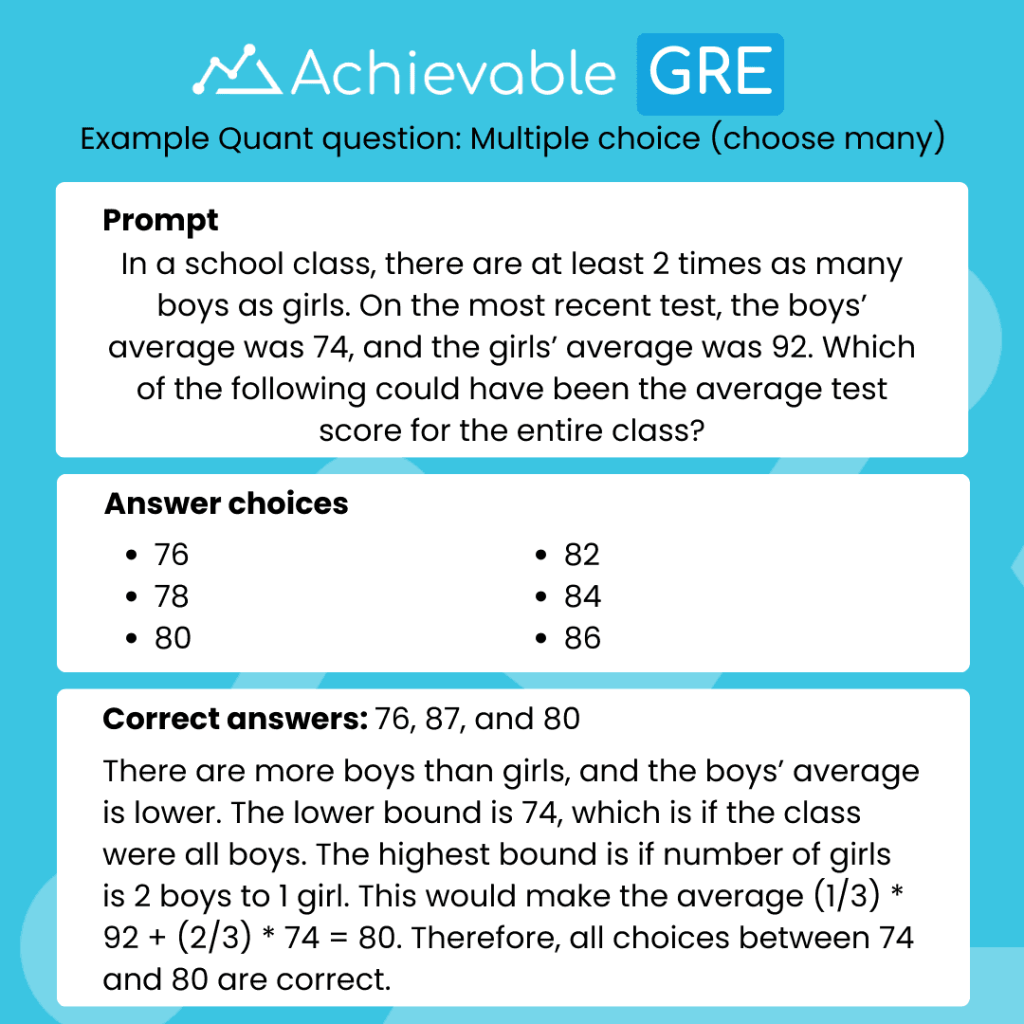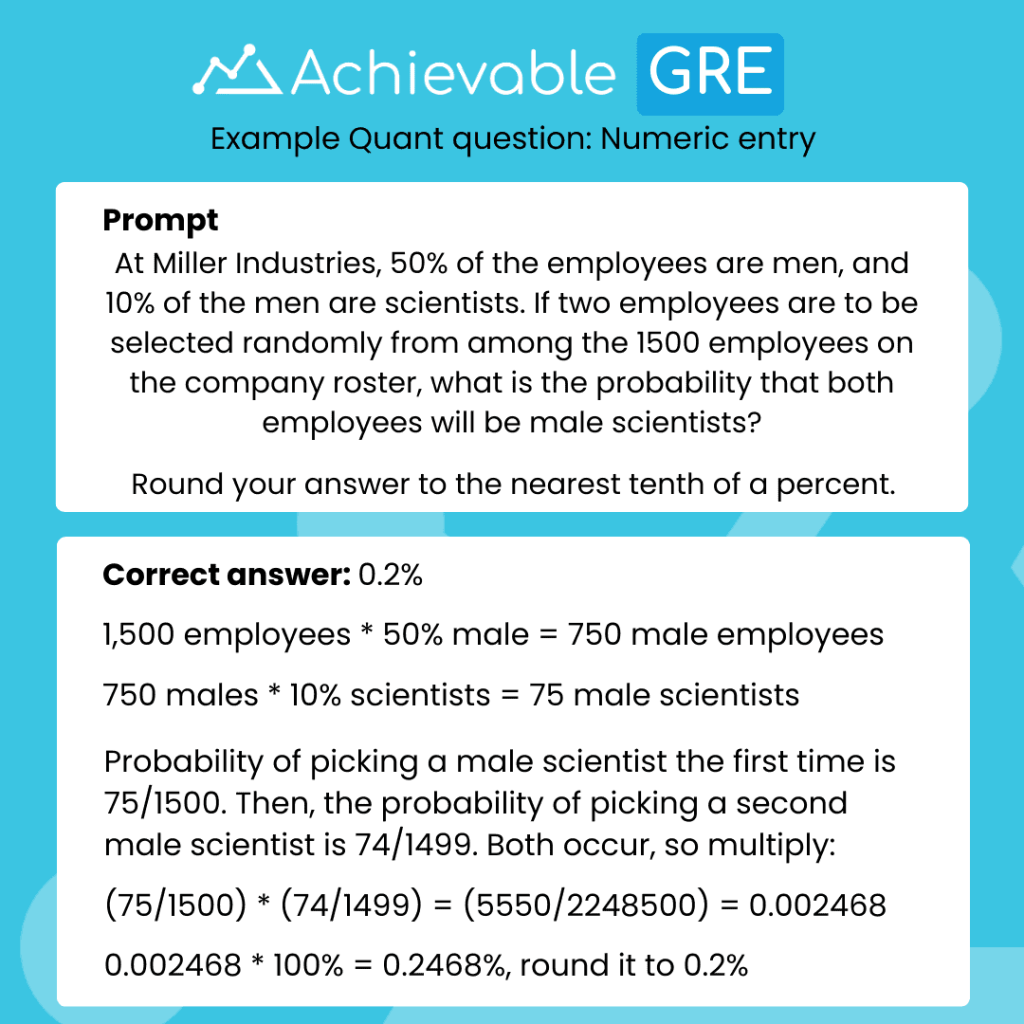
What is the GRE? The GRE, short for Graduate Record Examination, is a standardized test offered by ETS for graduate school admissions of all kinds, including business (MBA) and law programs. In this post, we will cover everything you need to know about the GRE, including when, where and how to take the test; how the GRE is scored and what is a good GRE score; how hard is the GRE; how to send scores; tips for studying for the exam; and much more. Read on for a deep dive into the GRE, and use the Table of Contents below to go to any specific question that you have.

The GRE test consists of three sections: Verbal Reasoning, Quantitative Reasoning, and Analytical Writing.
From the ETS website, the GRE Verbal Reasoning section measures your ability to:
The GRE Verbal Reasoning section has three question types, which are all tested through multiple-choice questions:
The questions on Reading Comprehension are based on passages on topics ranging from the physical sciences, biological sciences, social sciences, business, arts and humanities and everyday topics. The passages are based on material found in books and periodicals, both academic and nonacademic. You will need to be able to read these graduate school-level passages and understand them; distinguish their key points; infer missing information; identify the author’s position and its strengths and weaknesses; and draw conclusions from the passage.
From the name itself, test takers are to fill in the blanks to complete the text from a passage that is composed of one to five sentences. If there is only one blank, there will be five answer choices; if there are two or three blanks, there will be three answer choices per blank. The answer choices function independently (although the context of one may be relevant for the others) and there is a single correct answer per blank.

The Sentence Equivalence questions consist of a single sentence with just one blank and six choices. From these choices, you must select two from the answer choices that lead to a complete, coherent sentence while producing sentences that mean the same thing as a whole context.

From the ETS website, the GRE Quantitative Reasoning section measures your ability to:
The GRE Quantitative Reasoning focuses on arithmetic, algebra, geometry, data interpretation (tables and charts), and statistics. It does not include questions that are beyond 11th grade level math, such as trigonometry, calculus, the ability to construct a proof, or inferential statistics.
The GRE Quantitative Reasoning section has four question types:
This is the trickiest of the four question types on the GRE Quantitative Reasoning. Quantitative Comparison questions ask you to compare two quantities, which often include variables. You are asked to pick one of four answers:
The answer choices are always the same for every quantitative comparison question so it’s easy to keep them straight.

Your standard multiple choice question – figure out the right answer and choose it from among the four answers. Be sure to eliminate wrong answers to increase your chances for success.

Similar to regular multiple choice, but this type has a twist: you can select one or many answers. Pay close attention to what the question is asking and how many answers you should select.

Numeric Entry questions simply give you a text box where you must enter your answer. These questions will often ask you to round to the nearest whole number or similar, so pay close attention to the instructions to ensure you aren’t accidentally disqualified.

Unlike the other two sections, the Analytical Writing section does not involve questions. Instead, you write an essay that is both human and computer-graded by ETS afterwards. The GRE currently contains two writing assignments: Analyze an Issue and Analyze an Argument. After September 23rd, 2023, the GRE Analytical Writing section will only contain the Analyze an Issue section.
From the ETS website, the GRE Analytical Writing section measures your ability to:
You do not need to know any specific information to prepare for the GRE Analytical Writing section. They will give you enough information or use general-enough topics that anyone can write about them without preparation. Consult the official GRE Issue Topic Pool and Argument Topic Pool for more information.
The truest measure of success is what an individual is able to accomplish.
Write a response in which you indicate the extent to which you agree or disagree with the above statement. Be sure to support your position with appropriate reasons and/or examples.
The following is an internal bulletin released by the Chairman of the Board of Directors at MicroStar.
“Ever since Paul Browning was promoted to CEO of MicroStar one year ago, the company has been in an unmitigated downward spiral. Not only has Browning overseen the most ruinous fiscal year in the history of the company, but he has also seen exceptionally high turnover among his direct reports. This functionally constitutes a vote of no confidence on the part of his employees, who are seeking better opportunities elsewhere. On the other hand, Eiko Kanazawa, MicroStar’s current head of marketing, has successfully conducted her division through its most productive year to date, while coming in significantly under budget at the same time. Therefore, the Board should replace Browning with Kanazawa as CEO of MicroStar as soon as possible.”
Write a response in which you evaluate the explicit and/or implicit assumptions in the presented argument. Make sure to discuss how the argument would be impacted by the confirmation and/or disconfirmation of these assumptions.
How long does the GRE take? Starting September 22, 2023, ETS is releasing a shorter GRE exam that will take a lot less time. The entire GRE exam used to be 3 hours and 45 minutes long, but the new GRE is much shorter, and will take just 1 hour and 58 minutes. Below is a breakdown of the allotted time for each section:
| Section | Structure | Estimated Timing |
|---|---|---|
| Analytical Writing | 1 section, 1 essay | 30 minutes |
| Quantitative Reasoning | 2 sections, 27 questions total | 47 minutes total |
| Verbal Reasoning | 2 sections, 27 questions total | 41 minutes total |
| Total | 5 sections | 1 hour, 58 minutes |
The allotted time for each question is roughly the same, so the test should be similar to the previous iteration, just shorter.
How much does it cost to take the GRE? The GRE exam fee is $220 in all areas of the world, including the United States, except for China and India. In China, the price is $231.30, and in India, the price is ₹ 22,550 or $273.17 as of August 2023.
You will have to pay an additional fee as well for the following services:
All prices are from the ETS GRE fee website, which was last updated July 1st, 2023. These fees will be slightly different in China and India as well – please refer to the ETS website for more information.
For New York state residents, ETS has also made available a question and answer review service for the Verbal Reasoning & Quantitative Reasoning sections for $50.

So how hard is the GRE? The general consensus is that the GRE is more difficult than college entrance exams such as the ACT and SAT, but not quite as hard as some other graduate admissions tests like the GMAT, LSAT, or MCAT. This is because the GRE is a general test that doesn’t require knowledge in a specialized field (like the LSAT or MCAT) or advanced math and logic skills (like the GMAT).
That’s not to say that the GRE is easy either. Below, we outline the key challenges that make the GRE test difficult:
Vocabulary
Compared to other graduate admissions exams, the GRE is the one with the largest emphasis on vocabulary. This is manageable for most native English speakers with a good vocabulary and some studying, but can be particularly challenging for ESL students.
Math
The GRE Quantitative Reasoning section is pretty much all math, and specifically covers algebra, geometry, statistics, and data interpretation. If you struggled with high school math, this will be a tough section for you. And many who take the GRE later in life will have forgotten some of the rules and equations that are necessary to ace the test (you don’t need to calculate the area of a parallelogram in most jobs). The computer-based GRE calculator that you’re required to use is also somewhat clumsy to use and can be challenging for test takers that are used to more advanced calculators.
Not-so-straightforward questions
Unlike the SAT or ACT, which ask you straightforward questions, GRE questions can be intentionally tricky. While the GRE is less bad about this than the GMAT, it still has its fair share of questions that are written in a way that will lead you to a wrong answer choice at first glance. Make sure you’re carefully reading the questions and understand what they’re really asking for.
Timing
The GRE offers you 90 seconds per Verbal Reasoning question and 105 seconds per Quantitative Reasoning question. While this is more time than you got per-question on the ACT or SAT, these questions are a lot more complex and thus take longer to solve. Many people find that the time constraint is one of the most challenging aspects of the GRE test, which is why knowing shortcuts and how to identify answers quickly is so important.
The writing section
While the writing section has been reduced from two essays to one in the new GRE format coming out September 22nd, 2023, it is still challenging to write a good and long essay in just 30 minutes. Our GRE essay research found that an essay with 750 words or more was likely to get a higher score – hitting that target means writing 25 words per minute. That’s harder than it looks when you include time for planning the essay, structuring it, and writing it in a high quality way.
All in all, the GRE is considered ‘medium’ difficult in the context of other graduate school exams. It’s not an easy test by any means – it is assessing fitness for graduate school-level academics – but it’s not as tricky as the GMAT or challenging as the MCAT or LSAT. With proper preparation, you can reach your target GRE score and get into your target graduate program. More on that below.

Your GRE score is actually two parts. First, there is your raw score, which is how many problems you got right on the exam. Then, that raw score is converted by ETS into a scaled score, which is what you actually see when you get your report and what institutions will see when you submit scores.
How your raw score converts into your scaled score is determined by a number of factors, including the difficulty of the questions you got right and wrong and the grading curve of the test population overall. Your scaled score is scored for each section individually:
The GRE’s max score is 340 (combined scores range from 260-340). The average GRE score is a 304, constituted by a 151 on Verbal and a 153 on Quantitative. The Analytical Writing average is 3.6.
What is a good score on the GRE? The best way to gauge a good GRE score is by reviewing GRE scores as GRE percentiles. A percentile is essentially what percentage of total test takers that the score beats. So a score that is 80th percentile is better than 80% of all GRE test takers. With that in mind, here is a table of the GRE score percentile and scores associated for all three sections:
| GRE Score Percentile | Quantitative | Verbal | Analytical Writing |
|---|---|---|---|
| 99% | 170 | 169 | 6.0 |
| 90% | 167 | 162 | 5.0 |
| 80% | 162 | 158 | 4.5 |
| 70% | 159 | 155 | |
| 60% | 156 | 153 | 4.0 |
| 50% | 153 | 151 | |
| 40% | 150 | 148 | 3.5 |
| 30% | 148 | 146 | |
| 20% | 145 | 143 | 3.0 |
| 10% | 142 | 139 | 2.5 |
Now, these are national scores, so while this is helpful if you’re curious about the average GRE score, it probably isn’t directly applicable to your needs. The real question is: What is a good GRE score for the program I am applying to? For this, you need to find the median GRE score and score range for admitted students to the program you’re applying to. Even within universities, different programs (ie Arts vs. Engineering) will have dramatically different GRE score requirements. Take a look at the chart below for nationwide averages for popular programs:
| Masters Degree | Average GRE Verbal | GRE Verbal Percentile | Average GRE Quant | GRE Quant Percentile |
|---|---|---|---|---|
| Business | 150 | 50% | 153 | 50% |
| Social sciences | 153 | 60% | 151 | 40% |
| Physical sciences | 151 | 50% | 158 | 60% |
| Life sciences | 151 | 50% | 151 | 40% |
| Arts and humanities | 157 | 70% | 150 | 40% |
The scores you need to get generally correlate with what skills are most important in the major. For instance, Physical Sciences majors require a lot more quantitative skills than verbal skills. As a further example, look at what GRE score you need to get into Harvard:
| Degree | Average GRE Verbal | GRE Verbal Percentile | Average GRE Quant | GRE Quant Percentile |
|---|---|---|---|---|
| Business (MBA) | 165 | 96% | 163 | 82% |
| Engineering | 160 | 85% | 167 | 92% |
| Computer Science | 155 | 69% | 161 | 78% |
| Mathematics | 165 | 96% | 167 | 92% |
| Psychology | 163 | 93% | 154 | 53% |
| Physics | 167 | 98% | 167 | 90% |
| Chemistry | 154 | 64% | 163 | 82% |
| Education | 163 | 93% | 158 | 67% |
And what GRE score you need to get into Stanford:
| Degree | Average GRE Verbal | GRE Verbal Percentile | Average GRE Quant | GRE Quant Percentile |
|---|---|---|---|---|
| Business (MBA) | 165 | 96% | 165 | 86% |
| Engineering | 159 | 82% | 167 | 93% |
| Computer Science | 160 | 86% | 164 | 87% |
| Mathematics | 165 | 96% | 167 | 92% |
| Psychology | 163 | 93% | 154 | 53% |
| Physics | 167 | 98% | 167 | 90% |
| Chemistry | 164 | 94% | 163 | 82% |
| Education | 161 | 88% | 156 | 60% |
Research this for your target schools and programs, and then you will have a much better idea of what GRE score you need to get. See our post on GRE percentiles for more detail and GRE percentile info for 10 top colleges.
Between the GMAT and GRE, the GRE generally offers better admissions chances – in the most prestigious business schools, the median accepted GRE scores are an average of 9 percentile points lower than median GMAT scores:
On average, the GRE to GMAT conversion for similar percentiles makes the GRE the more attractive and attainable option. For more detail, read our post on GMAT vs. GRE.

The GRE is offered year-round at accredited test centers like Prometric or at home. To determine the best time to take the GRE, there are two key considerations:
Most graduate school applicants apply for a Fall Semester start. These application deadlines are typically in December. Spring Semester application deadlines are typically in August.

From here, you can work backwards:
In total, you want to prepare to take your first GRE at least 15 days before the earliest score submission deadline of the schools you’re applying to. And if you want to have two GRE attempts, then you’d want to take your first GRE at least 36 days before the deadline. As we outline below in the How to prepare for the GRE section, you will probably want at least two, preferably three months to study.
ETS takes approximately 10 to 15 days to send your GRE scores to schools. They expect that this will be reduced to 5 to 10 days with the new GRE coming out on September 23rd, 2023, but we recommend leaving the extra time. You will receive an email notification that your official scores are now available in your ETS Account.
Source: ETS.org 2023
Taking the GRE as a current student is recommended for people with a strong intent to apply to graduate school immediately after undergrad or within a couple years. Your GRE score is valid for five years, and conventional wisdom is that people still currently in school have more contextual knowledge. Put simply – you’re already studying and taking tests far more often than someone in the working world, so you’re probably going to be better prepared.
Looking at the calendar, you’ll notice that GRE prep for a December deadline would occur during a fall semester if you’re a current student. For this reason, you may want to study for and take the GRE during the summer instead, even if you’re applying for a fall program.
If you’re applying for a spring semester intake program, then you can and should also study during the summer, but the timing is a lot more obvious – most spring semester deadlines are in August.
How long to study for GRE? A general rule of thumb is that you should expect to study for at least 2 to 3 months, but the truth is that the amount of time you study matters a lot more than the timeframe you study over. You should expect to spend at least 100 hours studying, which over 12 weeks is about eight hours per week. And the more time you spend studying, the more time you have to improve your score.
How much you need to study also depends on what your current score is, and what score you want to reach. To determine your current score, take one of the free ETS PowerPrep official GRE practice tests – this will be the most accurate measure of your true GRE score. Then, look up the GRE percentiles of the program you’re applying for. The further that your current score is from your target score, the more you need to study. And the closer that your target score is to a maximum 170 score, the more difficult it will be to get there.
The industry estimate is that increasing your score 5 points on the GRE takes 40 hours. Study habits vary and learning speed depends on the individual, but it’s good to put the numbers down to be realistic about how much work you have ahead of you:
These are rough guidelines, but should give you a sense of the scale of the challenge ahead of you and how much studying you need to do to get there.
Studying for the GRE as a working professional can be challenging, and not just because you’re out of practice. The #1 reason professionals have difficulty studying is time. Your work is time consuming, of course, but it’s your social life that will often be the biggest challenge to schedule around. If you make plans to study every Wednesday night at 6pm, and your friend invites you to dinner, you need to either keep your schedule or reschedule your study time.
The goal here is to be realistic – how many hours per week will you actually study? Recall the 100 hour target that we shared earlier, and map out your study schedule versus your test date. Be honest with yourself and don’t be afraid to adjust your schedule if you get two weeks in and find yourself falling behind. For this reason, we recommend that you schedule an extra month or even two for studying as a working professional. This gives you a buffer in case you have a conference or crazy week at work and still need to get your 10 hours in that week.
Before deciding if you should hire a GRE tutor, you should consider all of your options and consider what will work best for your learning style and schedule. At a high level, there are four main paths (ordered from least to most expensive):
In all of the above options, the quality of your course is going to vary depending on the instructor you get and the firm you work with. For online courses, the quality of the software product you’re using also makes a big impact on your studies.
An economical approach that many pursue is to start with an online self-study course, and then hire a tutor to target weak areas. But if cost is no object, then going with a tutor from the beginning will be your most personalized and hands-on option.

You must create an ETS account to register for the GRE. Your ETS account will be used for registration purposes and also gives you the following features:
By having an ETS Account, you get the most up-to-date test center information and help with determining which graduate institutions or fellowship sponsors you want to receive your scores. As part of your test fee, you can designate up to four score recipients. If you prefer to send score reports later or want to send score reports to more than four recipients, you can send additional score reports for a fee.
Create a Test Taker Account on the ETS website here. You can create an account at any time, regardless of whether or not you plan to register for a GRE test.
You will receive a confirmation page and your account is then set up. You can immediately register to take the GRE General Test. You will also receive a confirmation email – look for that to make sure you entered your email correctly and that the ETS emails are not going to your Spam Folder.
Your ETS account will let you view, change or cancel your registration and purchase test preparation materials prior to test day. Then after test day, you will use your account to view your scores, order Additional Score Reports, access the free GRE Diagnostic Service, amongst others.
Log in and confirm details
Log directly into the ETS Account you created at www.ets.org/mygre. Enter your username and password in the “Returning Users” field or signing in for Test Takers
You will be redirected to their My GRE home page which shows your registered full name and ETS ID number. Make sure your registered full name matches the full name on your government ID.
Pick a test center
Now it’s time to select your test center and date. Select the blue “Register/Find Test Centers, Dates” button, and then select the test (GRE General Test) you want to take from the drop down box. You can search for a test date by sorting with the “By Date” or “By Distance” tabs.
Test dates are displayed in a two-month period window. Use the blue arrow to change months if your preferred test date is outside of the two-month window.
Finalize your test date
Review the test, test date, time and test center location information in the yellow shaded box at the top of the page. For any changes, just select the blue “Edit Test Information” button. Review the registration policies and if you agree, check the “I understand” box at the bottom of its page and select “Next.” You will be redirected to review the personal information you entered.
Once you confirm it is all in order, select the blue “Next” button. You will be asked of your interest to participate in the free GRE Search Service. Review the full details, select your preference and select the blue “Next” button.
Then, confirm your purchase/s by selecting the blue “proceed to checkout” button. This is where you enter any voucher or promotional code you may have at the top of the page and select the blue “Apply” button to activate it. Select the blue “Pay Now” button, and then select your payment option from Credit or Debit card, US bank funds transfer or PayPal. Once complete, click “Buy”. You will be taken to a confirmation page and sent a confirmation email – be sure to check this to confirm that all of your details are correct.
The GRE General Test is available at more than 1,000 test centers, such as Prometric, in more than 160 countries. The GRE can also be taken at home under specific controlled conditions. Both are monitored by a human proctor.
ETS offers the computer-delivered test all year round and is on a first-come, first-serve basis based on their published seat availability within a two-month period for that testing center. The vast majority of students take the computer-delivered test.
The paper-delivered GRE exam can only be taken in locations where you are not able to take the computer-delivered version or eligible for the at-home GRE. For the paper-delivered version, test takers are required to choose a testing center before being provided with the center’s seat availability.
To schedule a GRE test in your area, go to this ETS website and use their search function to find the nearest test center.
Yes, you can take the GRE at home. You can take the GRE test at home 7 days a week, 24 hours per day, and appointments can be made as early as just 24 hours after you register. In order to test at home, you must be in an eligible country and meet the ETS Equipment and Environment Requirements, which are:
GRE Equipment requirements for At-Home administration
GRE Environment requirements for At-Home administration
GRE dress code requirements for At-Home administration
A valid and acceptable ID must be provided with the first and last name clearly stated and matching the registration information. ETS recommends bringing two forms of acceptable ID, which, in general, are government-issued photo IDs. The ID must be:
In the event that the ID does not exactly match the name on the registration, you will not be permitted to test and your test fee will not be refunded. The GRE has to deal with a lot of potential cheaters, so they will not be able to cut you a break if you forget this.
For your comfort, bring water, snacks, and a sweatshirt or jacket. You want the water and snacks to keep your energy levels high throughout the test period, and you want warm clothes in case the test center is cold (it often is). You do not need to bring calculators or scratch paper, as these components are either provided on site or integrated into the testing software.
You can take the test once every 21 days, but only up to five times within a 12-month period (365 days). This rule applies even if you canceled your scores on an earlier test.
To answer this question, we hand-scored over 1,000 GRE essays and used machine learning to crunch the numbers. What we found is that essay length is one of THE most important things you can do to improve your GRE essay score. You should aim for an essay length of 750 words, preferably closer to 1,000 words in order to get the maximum score for word count in GRE essay grading.
Our GRE essays post has more detail on what affects your score, examples with grading and score contributions by subject, and our post on GRE essay topics also has additional examples.

Once you take the GRE, you now need to get your test scores sent to different colleges and potentially consider taking the test again. Here’s the answers to your most frequently asked questions for what to do after taking the GRE:
ETS takes approximately 10 to 15 days to send your GRE scores to schools. They expect that this will be reduced to 5 to 10 days with the new GRE coming out on September 23rd, 2023, but we recommend leaving the extra time. You will receive an email notification that your official scores are now available in your ETS Account.
If you took the paper-based test (normally for test-takers outside of the United States), you can view your scores online around five weeks after your test date.
The simple answer is yes. After the GRE exam, you will be able to view your unofficial scores for the Verbal Reasoning and Quantitative Reasoning sections of the exam. Due to the scoring process of the Analytical Writing section of the GRE test, which requires a human grader, you will not have access to this score at the test center. However, remember that the scores you see immediately are the ‘unofficial scores’ – your ‘official scores’ will be made available in your ETS Account online later and are the ones actually sent to schools.
The scores you will be able to access at the end of the GRE test are your unofficial scores for the Verbal and Quantitative Reasoning sections. These are unofficial since your scores are subject to change in the normalization process for that version of the test. That said, students’ unofficial scores will be the same as their official scores the vast majority of the time, and any changes will be (at most) one point in either direction. Your official scores will include all sections of the exam and will be made available within 15 days of your test date.
Your GRE scores are valid for 5 years after your test date. This means that if you are ambivalent about your plans for the future, or maybe you want to take the test again to gain better scores, you will have plenty of time to decide.
ETS will keep your score on file for that length of time as well. After that, your records are purged from the ETS database and will no longer be accessible.
Your test fee comes with the option to send your test scores to up to four graduate schools or programs for free.
You can send your test scores to more than four programs for as long as your scores are valid for a small fee.
With the ScoreSelect option, you can choose to send scores from your Most Recent, All, or Any test available from your reportable history. So, you have the option to retake the test and choose the best scores to submit to your programs of interest.
Please note that once a score report request is submitted, it cannot be canceled, changed, or refunded.
How long does it take to send GRE scores? It will take about the same time as it took for your official scores to become available in your ETS Account, namely: 10 to 15 business days. After the new GRE is released in September 2023, ETS hopes to reduce this to 5 to 10 business days.
If you order additional score reports, your reports will be sent 5 to 10 business days after your order is placed.
GRE Subject tests are generally required for higher studies in Biology, Chemistry, English Literature, Mathematics, Physics, and Psychology. While the GRE Subject Test is not required for most graduate school programs, it could give you a competitive advantage over other candidates if the test is relevant to that program.
So you want a better score to get into a top university’s graduate program? Or maybe you didn’t meet the required GRE score of your chosen institution? The good news is you can take the test again. You can do so once every 21 days and up to five times within a 12-month period (365 days). This applies to all tests, including any canceled administrations.
